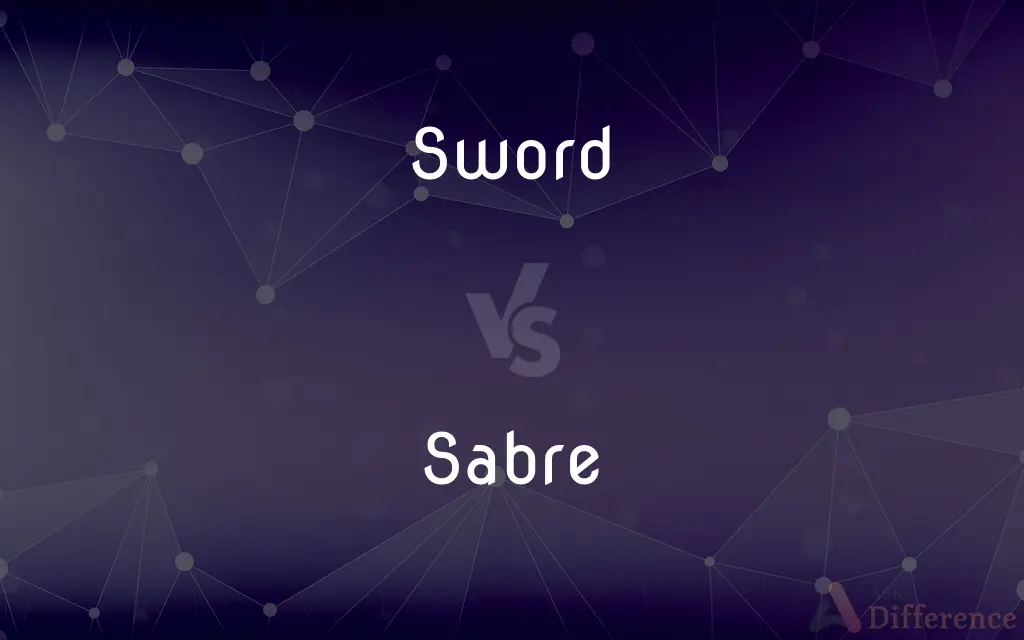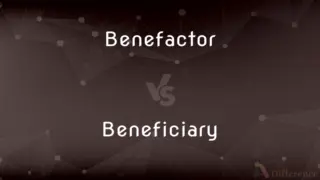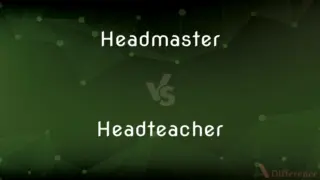Sword vs. Sabre — What's the Difference?
By Tayyaba Rehman — Updated on October 12, 2023
Sword is a broad-bladed weapon used for cutting or thrusting. Sabre is a curved, single-edged sword primarily used for slashing.

Difference Between Sword and Sabre
Table of Contents
ADVERTISEMENT
Key Differences
A sword is a general term that describes a weapon with a long blade attached to a hilt. It has been used throughout history by various civilizations for combat and ceremonial purposes. A sabre, on the other hand, has a distinctive curved shape and is often single-edged, designed mainly for slashing attacks.
The sword can come in many forms, such as the straight double-edged longsword or the single-edged scimitar. Its design allows for a combination of cutting, slashing, and thrusting techniques. The sabre is a type of sword that evolved from the cavalry weapons of Eastern Europe and Asia, and its curve facilitates fast, sweeping attacks.
In terms of construction, a sword usually has a crossguard to protect the wielder's hand, and its blade can be broad or slender based on its intended use. A sabre, while also having a guard, often incorporates a knuckle bow for additional hand protection.
Historically, the sword has been emblematic of knighthood, honor, and justice in many cultures. It has often been seen as a symbol of authority and power. The sabre, especially in the 18th and 19th centuries, became associated with cavalry charges and was a favored weapon of mounted troops.
In sports, fencing provides a modern manifestation of these weapons. The sword, in the form of the épée or foil, is used in precise, point-scoring thrusts. The sabre is also present in fencing, emphasizing cutting with the blade's edge.
ADVERTISEMENT
Comparison Chart
Shape
Typically straight, can be either single or double-edged.
Curved and usually single-edged.
Primary Use
Cutting, slashing, and thrusting.
Slashing.
Origin
Global, with different styles evolving in various regions.
Originated from Eastern Europe and Asia.
Symbolism
Often represents knighthood, honor, and justice.
Associated with cavalry and mounted charges.
Sport
Used as épée or foil in fencing.
Used in fencing with emphasis on cutting.
Compare with Definitions
Sword
An instrument of execution or sacrifice in ancient times.
The gladiator fell by the sword in the arena.
Sabre
An emblem of certain military orders or units.
The regiment's insignia featured a shining sabre.
Sword
A weapon with a long blade for combat.
He drew his sword and prepared to defend himself.
Sabre
A symbol of swift and decisive action.
He cut through the argument like a sabre.
Sword
A tool in ceremonial or religious rituals.
The knight was dubbed with a ceremonial sword.
Sabre
A curved, single-edged sword for slashing.
The cavalryman charged with his sabre drawn.
Sword
A sword is an edged, bladed weapon intended for manual cutting or thrusting. Its blade, longer than a knife or dagger, is attached to a hilt and can be straight or curved.
Sabre
A fencing weapon emphasizing cutting techniques.
She chose the sabre for her fencing match.
Sword
A handheld weapon consisting typically of a long, straight or slightly curved, pointed blade having one or two cutting edges and set into a hilt.
Sabre
A sabre (sometimes spelt saber in American English) is a type of backsword with a curved blade associated with the light cavalry of the early modern and Napoleonic periods. Originally associated with Central European cavalry such as the hussars, the sabre became widespread in Western Europe in the Thirty Years' War.
Sword
An instrument of death or destruction.
Sabre
Variant of saber.
Sword
The use of force, as in war.
Sabre
A light sword, sharp along the front edge, part of the back edge, and at the point.
Sword
Military power or jurisdiction.
Sabre
A modern fencing sword modeled after the sabre.
Sword
(weaponry) A long-bladed weapon device with a grip- a hilt (a pommel and cross guard), which is designed to cut, stab, slash and/or hack.
Sabre
To strike or kill with a sabre.
Sword
(tarot) A suit in the minor arcana in tarot.
Sabre
See Saber.
Sword
(tarot) A card of this suit.
Sabre
A fencing sword with a v-shaped blade and a slightly curved handle
Sword
(weaving) One of the end bars by which the lay of a hand loom is suspended.
Sabre
A stout sword with a curved blade and thick back
Sword
(heraldry) The weapon, often used as a heraldic charge.
Sabre
Cut or injure with a saber
Sword
To stab or cut with a sword
Sabre
Kill with a saber
Sword
An offensive weapon, having a long and usually sharp-pointed blade with a cutting edge or edges. It is the general term, including the small sword, rapier, saber, scimiter, and many other varieties.
Sabre
A weapon used primarily by cavalry troops.
The mounted warrior was proficient with his sabre.
Sword
Hence, the emblem of judicial vengeance or punishment, or of authority and power.
He [the ruler] beareth not the sword in vain.
She quits the balance, and resigns the sword.
Sword
Destruction by the sword, or in battle; war; dissension.
I came not to send peace, but a sword.
Sword
The military power of a country.
He hath no more authority over the sword than over the law.
Sword
One of the end bars by which the lay of a hand loom is suspended.
Sword
A cutting or thrusting weapon with a long blade
Sword
A symbol of power or authority.
The sword of justice will always prevail.
Sword
A part of the coat of arms representing valor.
The family crest featured two crossed swords.
Common Curiosities
Are all swords straight?
No, while many swords are straight, there are curved variants like scimitars and, of course, the sabre.
Are swords and sabres still used in modern combat?
While both have historical significance, they're largely ceremonial today and not primary weapons in modern combat.
Can both the sword and sabre be used in fencing?
Yes, the sword, in forms like the épée or foil, and the sabre are both used in modern fencing.
Which is older in origin, the sword or the sabre?
The sword, in its various forms, predates the sabre, which evolved later.
What distinguishes a sabre from other swords?
A sabre is a curved, single-edged sword, primarily designed for slashing.
What is a sword?
A sword is a weapon with a long blade attached to a hilt, used for cutting, slashing, or thrusting.
Can you name a famous sword?
Excalibur, the legendary sword of King Arthur, is a famous sword.
Is the sabre more associated with any specific military group?
The sabre is historically linked with cavalry units, especially in the 18th and 19th centuries.
Why is the sabre curved?
The curve of the sabre facilitates quick, sweeping slashes, which was effective especially for mounted troops.
Can a sword be a symbol?
Yes, swords have symbolized power, authority, and justice in various cultures.
How about a famous sabre?
The light sabre from "Star Wars" is a renowned fictional variant of a sabre.
Are the techniques for wielding a sword different from a sabre?
Yes, due to their designs, swords might emphasize thrusts and cuts, while sabres focus more on slashing techniques.
In terms of maintenance, do swords and sabres require special care?
Yes, both need regular cleaning, sharpening, and protection from moisture to prevent rusting and deterioration.
In literature, how are swords and sabres depicted?
Swords often symbolize heroism, knighthood, or magic, while sabres might represent swiftness, cavalry, or Eastern warriors.
How does the weight of a typical sword compare to a sabre?
Weights can vary, but sabres, designed for quick slashes, are often lighter than some heavy cutting swords.
Share Your Discovery

Previous Comparison
Benefactor vs. Beneficiary
Next Comparison
Headmaster vs. HeadteacherAuthor Spotlight
Written by
Tayyaba RehmanTayyaba Rehman is a distinguished writer, currently serving as a primary contributor to askdifference.com. As a researcher in semantics and etymology, Tayyaba's passion for the complexity of languages and their distinctions has found a perfect home on the platform. Tayyaba delves into the intricacies of language, distinguishing between commonly confused words and phrases, thereby providing clarity for readers worldwide.















































